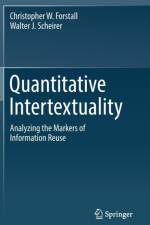- Analyzing the Markers of Information Reuse
von Walter J. Scheirer & Christopher W. Forstall
113,00 €
This book introduces quantitative intertextuality, a new approach to the algorithmic study of information reuse in text, sound and images. Employing a variety of tools from machine learning, natural language processing, and computer vision, readers will learn to trace patterns of reuse across diverse sources for scholarly work and practical applications.The respective chapters share highly novel methodological insights in order to guide the reader through the basics of intertextuality. In Part 1, "Theory", the theoretical aspects of intertextuality are introduced, leading to a discussion of how they can be embodied by quantitative methods. In Part 2, "Practice", specific quantitative methods are described to establish a set of automated procedures for the practice of quantitative intertextuality. Each chapter in Part 2 begins with a general introduction to a major concept (e.g., lexical matching, sound matching, semantic matching), followed by a case study (e.g., detecting allusions to a popular television show in tweets, quantifying sound reuse in Romantic poetry, identifying influences in fan faction by thematic matching), and finally the development of an algorithm that can be used to reveal parallels in the relevant contexts.Because this book is intended as a "gentle" introduction, the emphasis is often on simple yet effective algorithms for a given matching task. A set of exercises is included at the end of each chapter, giving readers the chance to explore more cutting-edge solutions and novel aspects to the material at hand. Additionally, the book's companion website includes software (R and C++ library code) and all of the source data for the examples in the book, as well as supplemental content (slides, high-resolution images, additional results) that may prove helpful for exploring the different facets of quantitative intertextuality that are presented in each chapter.Given its interdisciplinary nature, the book will appeal to a broad audience. From practitioners specializing in forensics to students of cultural studies, readers with diverse backgrounds (e.g., in the social sciences, natural language processing, or computer vision) will find valuable insights.


